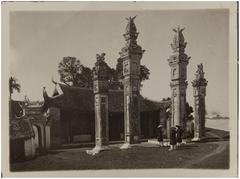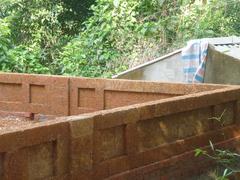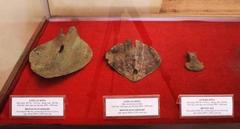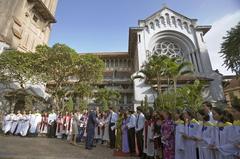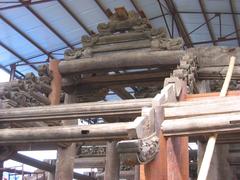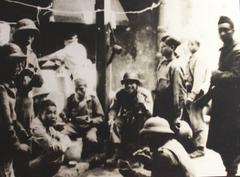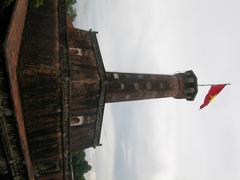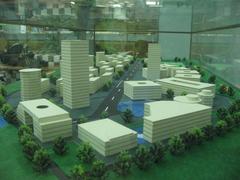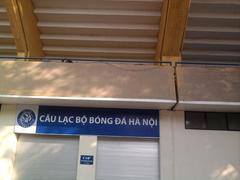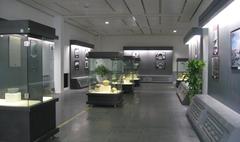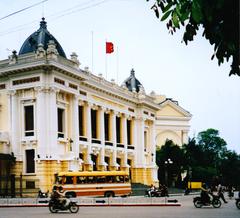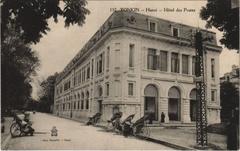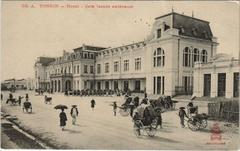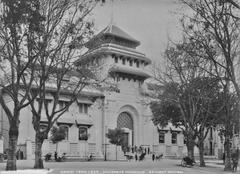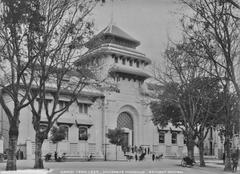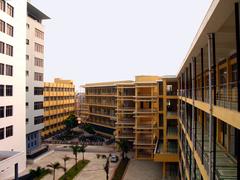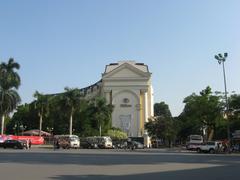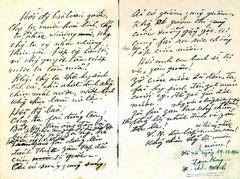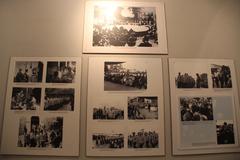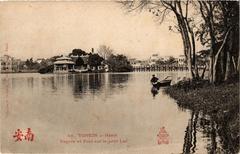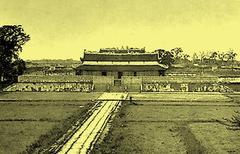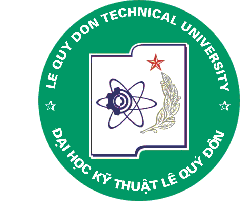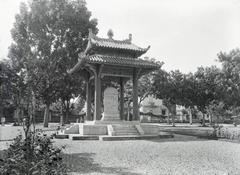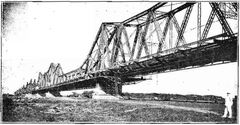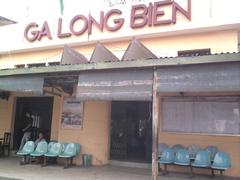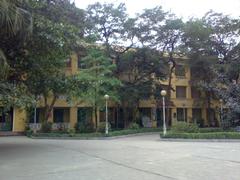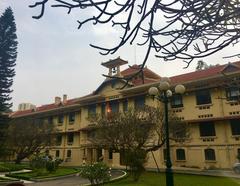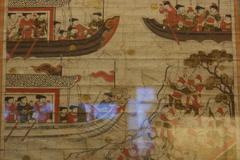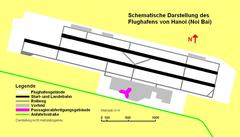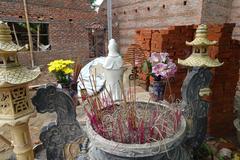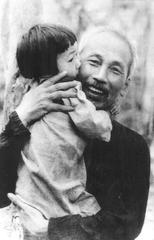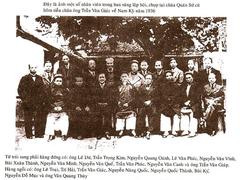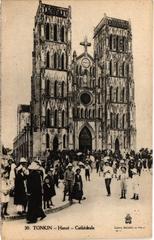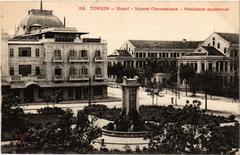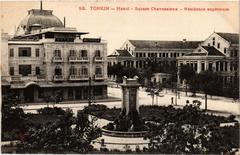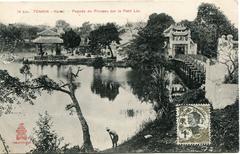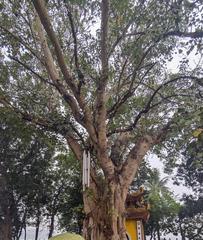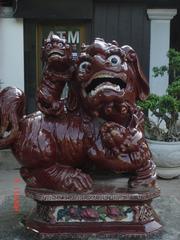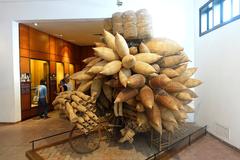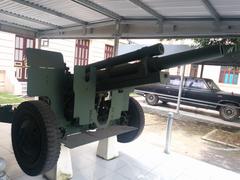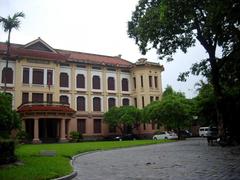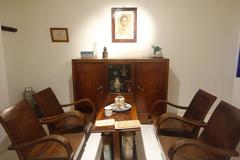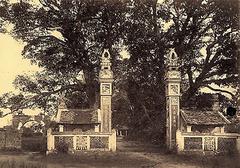Thầy Temple Hanoi: Visiting Hours, Tickets, and In-Depth Tourist Guide
Date: 14/06/2025
Introduction to Thầy Temple: History, Culture, and Significance
Located about 30 kilometers west of central Hanoi in the tranquil village of Sài Sơn, Quốc Oai District, Thầy Temple (Chùa Thầy or Thiên Phúc Tự) is a revered spiritual and cultural landmark in Vietnam. Founded in the 11th century during the reign of Emperor Lý Nhân Tông, the temple honors Zen master Từ Đạo Hạnh (1072–1116)—a legendary Buddhist teacher, healer, and the originator of Vietnamese water puppetry (múa rối nước). Today, Thầy Temple is celebrated for its deep-rooted spiritual legacy, elegant Buddhist architecture, and picturesque natural setting at the base of Sài Sơn Mountain. It stands as a must-visit destination for travelers interested in Hanoi’s historical sites and Vietnam’s living cultural traditions (Official Tourism Site of Hanoi; Vietnam Paradise Travel).
Entering the temple complex, visitors encounter peaceful courtyards and three main halls—Outer, Middle, and Upper—each reflecting different aspects of Buddhist devotion, art, and history. The temple is also famous for its two covered bridges, Nhật Tiên Kiều (Sun Bridge) and Nguyệt Tiên Kiều (Moon Bridge), which cross Long Tri Lake and connect to islets where the first water puppet shows were performed. Every year, the Thầy Temple Festival (5th–7th day of the third lunar month) brings the site to life with vibrant rituals and water puppetry, uniting communities and visitors in celebration (Gonetovietnam; Pineqone).
This guide provides a thorough overview of Thầy Temple’s history, architecture, festivals, and practical visitor details—including opening hours, tickets, accessibility, and how to get there—ensuring a respectful and enriching experience for all visitors (Guide to Hanoi).
Table of Contents
- Introduction
- Historical Background and Cultural Significance
- Architectural Features and Natural Setting
- Visitor Information
- Thầy Temple Festival
- Frequently Asked Questions (FAQ)
- Visuals and Media Suggestions
- Conclusion
- References
Historical Background and Cultural Significance
Origins and Development
Thầy Temple was established in the 11th century and is intricately tied to Zen master Từ Đạo Hạnh. Over centuries, it has been a focal point for Buddhist practice and an enduring symbol of Vietnamese spirituality and community. The temple’s ongoing importance is reflected in its festivals, rituals, and continued use as a pilgrimage site.
Architectural Features and Layout
The temple sits at the base of Sài Sơn Mountain, blending harmoniously with its environment. Its three main halls are:
- Outer Hall (Tiền Đường): The principal worship area, housing statues of the Buddha and bodhisattvas.
- Middle Hall (Trung Đường): Dedicated to Từ Đạo Hạnh, featuring his statue and relics.
- Upper Hall (Thượng Đường): Reserved for key rituals and ceremonies.
Distinctive covered bridges, Nhật Tiên Kiều and Nguyệt Tiên Kiều, cross Long Tri Lake, linking the temple to small islets. These locations are central to the origin of Vietnamese water puppetry—a unique art form still performed today.
The Legacy of Từ Đạo Hạnh
Từ Đạo Hạnh is honored for his teachings, healing practices, and mystical feats. He is celebrated as the creator of water puppetry, which combines entertainment with Buddhist morals. The annual Thầy Temple Festival commemorates his life and draws thousands of visitors.
Religious and Cultural Importance
Thầy Temple is a living center for worship, festivals, and community gatherings. Its lakeside and mountain backdrop symbolize harmony between humanity and nature, a core value in Vietnamese spirituality.
Architectural Features and Natural Setting
Main Structural Elements
Thầy Temple is a prime example of Vietnamese Buddhist architecture, with:
- Curved, multi-tiered roofs: Symbolizing enlightenment and sheltering the temple’s halls.
- Intricate woodwork and carvings: Depicting dragons, lotuses, and clouds—representations of spiritual ascent and prosperity.
- Stone foundations and terracotta tiles: Providing structural strength and visual harmony with the landscape.
- Interior altars and statues: Gilded and lacquered, portraying the Buddha, Từ Đạo Hạnh, and other revered figures.
Integration with the Landscape
The temple’s layout takes full advantage of its setting at the foot of Sài Sơn Mountain. Long Tri Lake reflects the temple’s silhouette, while the bridges and islets create a tranquil, contemplative atmosphere. Surrounding gardens, ancient trees, and lotus ponds offer peaceful retreats and reinforce the temple’s connection to nature (Pineqone).
The complex expands into the mountain’s natural caves, accessible via stone paths—underscoring Vietnamese traditions of seeking enlightenment in nature.
Visitor Information
Visiting Hours
- Daily: 7:00 AM to 5:00 PM (may be extended during festivals).
Tickets and Fees
- Entrance Fee: Approximately 30,000 VND for adults (20,000–40,000 VND is typical).
- Discounts: Available for students and seniors.
- Water Puppet Show: Separate tickets (50,000–100,000 VND) during festivals or special performances.
- Purchase: Buy tickets at the entrance; advanced booking is recommended for large groups or festival visits.
Accessibility
- Grounds: Paved paths and main courtyards are accessible; some steps and uneven terrain may challenge visitors with limited mobility.
- Wheelchair Access: Limited; assistance may be required in some areas.
Getting There
- By Car or Motorbike: About 45–60 minutes from Hanoi via Highway 21B.
- Taxi/Ride-hailing: Grab and similar services provide direct transport.
- Public Bus: Available from Hanoi to Quốc Oai District, but may require transfers.
- Guided Tours: Local operators offer day trips, often including nearby attractions (localvietnam.com).
Guided Tours and Events
- Guided Tours: Available on-site or through travel agencies, with English-speaking guides on request.
- Special Events: Water puppet shows and cultural performances during the annual festival and on select weekends.
Nearby Attractions
- Tay Phuong Pagoda: Known for ancient wooden statues and hilltop views.
- Van Phuc Silk Village: Famous for traditional silk weaving.
- Duong Lam Ancient Village: Offers preserved rural architecture (vietnamtravel.com).
Thầy Temple Festival
History and Schedule
The Thầy Temple Festival is held annually from the 5th to the 7th day of the third lunar month (April or May). It honors Từ Đạo Hạnh with three days of ceremonies, processions, and folk performances (Vietnam Paradise Travel).
Key Rituals and Performances
- Incense Offering Ceremony: Initiates the festival with prayers and processions.
- Water Puppetry: Traditional puppet shows performed on the lake, accompanied by live music.
- Folk Games and Music: Local troupes present traditional songs and games.
- Closing Rituals: Final prayers and return of sacred objects.
Community Involvement
The festival is a collaborative event among Sài Sơn, Đa Phúc, and Thụy Khê villages. Villagers prepare, organize, and participate in all aspects—from rituals to puppet performances and food stalls—preserving tradition and fostering community pride.
Visitor Experience and Tips
- Best Time to Visit: Main festival day (6th day); arrive early for the best views.
- Dress and Etiquette: Wear modest clothing, remove shoes when entering temples, and be respectful during ceremonies.
- Facilities: Restrooms and food stalls are available; bring water and sun protection.
- Participation: Visitors are welcome to join rituals, enjoy performances, and sample local foods.
Preservation and Challenges
Authorities and local communities work together to protect the temple’s intangible heritage and balance tourism with preservation. Educational programs and documentation support the sustainability of rituals and performances.
Frequently Asked Questions (FAQ)
Q: What are Thầy Temple’s visiting hours?
A: 7:00 AM to 5:00 PM daily, extended during festivals.
Q: How much is the entrance fee?
A: 20,000–40,000 VND for adults; additional fees for water puppet shows.
Q: How do I get to Thầy Temple from Hanoi?
A: By car, taxi, motorbike, bus, or via guided tours (30 km from city center).
Q: Can I take photos inside the temple?
A: Generally yes, but ask before photographing inside worship halls or ceremonies.
Q: Are guided tours available in English?
A: Yes, through local operators and sometimes on-site.
Visuals and Media Suggestions
- Images: Main temple hall, covered bridges, water puppet shows, festival processions.
- Alt text suggestions: “Thầy Temple main hall at sunrise,” “Nhat Tien Bridge over Long Tri Lake,” “Water puppet performance at Thầy Temple Festival.”
- Interactive Map: Temple location, nearby cultural sites, and travel routes.
Conclusion
Thầy Temple embodies the harmonious interplay of Vietnam’s spiritual, architectural, and cultural heritage. From its origins as a Buddhist sanctuary and cradle of water puppetry to its role as a living community hub and festival site, the temple promises a memorable journey into the heart of Vietnamese tradition. With clear visiting hours, accessible ticketing, and a wealth of cultural experiences, Thầy Temple is an essential stop for any traveler seeking to understand Hanoi’s historical and spiritual landscape. Enhance your visit by downloading the Audiala app for guided tours, and explore more about Hanoi’s rich heritage through our recommended resources.
References
- Official Tourism Site of Hanoi
- Thầy Temple Wikipedia
- Vietnam Paradise Travel
- Gonetovietnam
- Pineqone
- Guide to Hanoi
- Archello
- Local Vietnam


